Article
Biogen to Offer Early Access to SOD1 ALS Treatment Tofersen
Author(s):
Formerly known as BIIB067, the antisense oligonucleotide is expected to be available for rapidly progressing patients in mid-July 2021, and for the broader SOD1-ALS population in the fall.
Toby Ferguson, MD, PhD

Biogen has announced that its investigational SOD1 amyotrophic lateral sclerosis (ALS) agent, tofersen, which is still being assessed in a phase 3 clinical trial (NCT02623699), will be made available to patients through a 2-phase compassionate use program beginning this summer.1
The first part of the access program is set to begin in mid-July 2021, with eligible patients including rapidly progressing patients—those with an ALS Functional Rating Scale-Revised (ALSFRS) slope decline greater than or equal to 2 points per month. Then, in the fall of this year, the company aims to offer access to the broader SOD1-ALS patient population—estimated to consist of near 2% of the greater ALS population—through an expanded access program, as long as there are no further study requirements, and specifically in countries where the practice is allowed by regulations and for whom Biogen can ensure future access to tofersen, formerly known as BIIB067 (FIGURE). All of this will take place prior to application submission to the FDA.
Individual requests for access must be submitted by the patient in question’s treating physician, Biogen noted. “As you know well, Biogen’s quest to defeat ALS spans decades. While we hope this study’s results will be positive, we know firsthand that promising drugs can fail in Phase 3 studies. We are committed more than ever to advance ALS research and to work alongside the community to evolve our processes to meet the needs of people impacted by ALS,” the company wrote in a statement.1
FIGURE. Compassionate and Early Access to Tofersen for SOD1-ALS

The phase 3 clinical trial, known as VALOR, includes multiple objectives and a 3-part design (Parts A, B, and C), and completed its 178-patient enrollment in January 2021. Part A was a single ascending dose component, while Part B was the multiple ascending dose component. Part C is the fixed-dose portion, making the overall phase of development as 1/2/3.
READ MORE: SMA Treatment Risdiplam Demonstrates Continued Improvements in FIREFISH Study
The primary objective of Parts A and B were to evaluate the safety, tolerability, and pharmacokinetics tofersen in adults with ALS—these parts were completed in January 2019. The secondary objective of Parts A and B was to evaluate the effects on levels of SOD1 protein in the cerebrospinal fluid (CSF). The primary objective of Part C is to evaluate the clinical efficacy of administered to adult participants with ALS and confirmed SOD1 mutation, and the secondary objectives are to evaluate the safety, tolerability, and pharmacodynamic effects when administered to those adult participants.
The phase 1/2 results from VALOR were published in the New England Journal of Medicine in July 2020, suggesting that the antisense oligonucleotide reduces the concentration of SOD1 in the CSF of patients. Ultimately, over a period of 12 weeks, the difference in the change from baseline in CSF SOD1 concentration favored that administered intrathecal tofersen, which was assessed in a number of doses—20 mg (n = 10), 40 mg (n = 9), 60 mg (n = 9), and 100 mg (n = 10)—compared to placebo across doses (n = 12). As for safety, CSF pleocytosis occurred in some participants receiving tofersen, and lumbar puncture-related adverse events (AEs) were observed in most participants.2
The geometric mean SOD1 concentration at baseline among those who received tofersen was 79.9 ng/mL in the 20-mg dose group, 140.9 ng/mL in the 40-mg dose group, 102.5 ng/mL in the 60-mg dose group, and 139.8 ng/mL in the 100-mg dose group. Comparatively, for placebo, the mean concentration was 84.6 ng/mL. At Day 85, the differences between the tofersen groups and placebo were 2 percentage points (95% CI, −18 to 27) for the 20-mg dose, −25 percentage points (95% CI, −40 to −5) for the 40-mg dose, −19 percentage points (95% CI, −35 to 2) for the 60-mg dose, and −33 percentage points (95% CI, −47 to −16) for the 100-mg dose. Respectively, the geometric mean ratios of the SOD1 protein concentrations among participants who received tofersen decreased overall by 1%, 27%, 21%, and 36%. Among those who received placebo, the ratio decreased by 3%.
Toby Ferguson, MD, PhD, vice president, and head, Neuromuscular Development Unit, Biogen, said in a statement at the time, “By evaluating genetically validated targets such as SOD1 in defined populations, we believe we can more quickly identify how to treat this devastating disease. Biogen is committed to furthering ALS research in an effort to potentially bring a therapy to people living with this rapidly progressing neurological condition.”3
For information on how to request access, click here.





